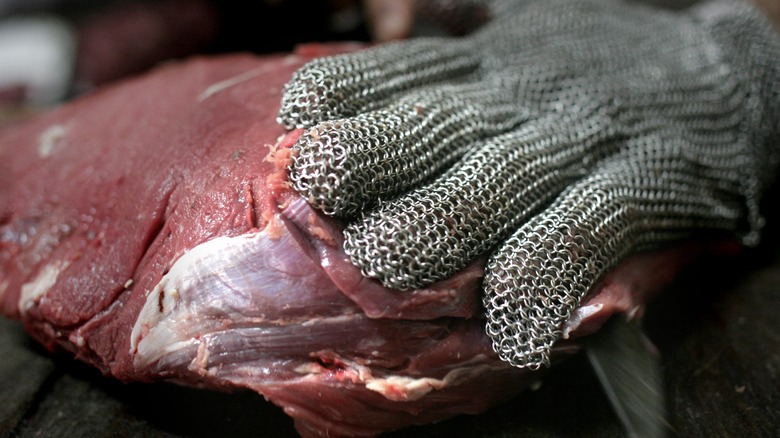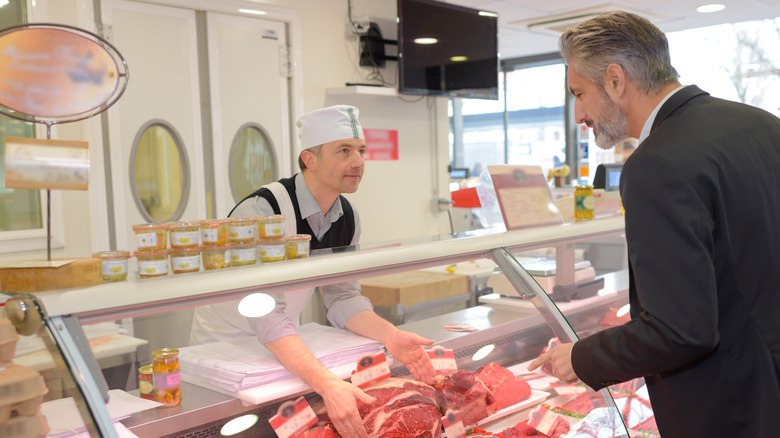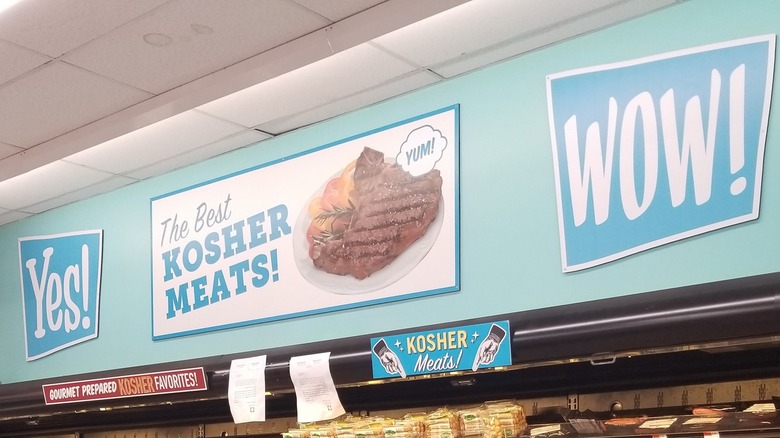What To Know When Shopping For Kosher Meat
Like many other Jewish customs, kosher laws can be very, very specific. The finer points of these dietary rules — known as kashrut — have been debated by rabbis and Talmudic scholars for centuries. But when it comes to meat, if you are looking to either feed guests that keep kosher, or looking to go kosher yourself, there are some very particular guidelines you'll want to be aware of.
Some rules about keeping kosher regarding meat are fairly well-known. For example, kosher means you steer clear of pork and shellfish, and the prohibition of mixing dairy with meat makes kosher cheeseburgers a rarity. But there is a lot more to it than that.
Shopping specifically for kosher meat can be made easier by looking for a henscher, or a symbol which explicitly marks a cut of meat as being certified kosher by one of many organizations specializing in it. Some are more common than others, and sometimes they can represent very particular differences in what makes meat kosher among various denominations and cultural backgrounds throughout the Jewish diaspora.
For example, a U circled by an O means that your product was certified by the Orthodox Union as kosher. An R flanked by two lower-case C's will be from the Chicago Rabbinical council. The Kosher Supervision of America is represented by a straightforward KSA, and some products simply say "kosher" in Hebrew on them. There is also Kashrut.com, which contains a far more comprehensive list of different kashrut organizations.
Getting kosher meat to market
As stated above, different kashrut organizations will likely have different standards for what is or isn't considered kosher. But most will share some basic characteristics. First, all kosher meat that comes from a mammal must come from a cloven-hoofed mammal –- also known as an ungulate –- and chew a cud. More specifically, this means that kosher meat comes from ruminants, animals that are both cloven-hoofed and have a four-chambered stomach to help them digest their entirely herbivorous diet (hence the cud). This includes cows, goats, sheep and lamb, deer, oxen, and buffalo.
The specific cut of the meat matters too. Kosher meat will almost always come from the forequarters of the animal, basically its front half. However, this doesn't apply to poultry. In terms of the kinds of poultry that are permitted, that is itself a debate. But by and large, duck, chicken, turkey, and goose are all considered kosher.
Kosher meat is also very specifically slaughtered and prepared. Only a specially trained slaughterer, called a shochet, may slaughter kosher meat. Generally, measures are taken to ensure that the slaughtered animals are killed instantaneously, so that they do not experience pain.
So what do these labels mean?
After the animal has been slaughtered, it is inspected to ensure that there were no internal injuries that might render it not kosher –- known as treif, which literally translates to "torn" in Yiddish. Both organs and meat are thoroughly examined, and certain parts of the animal which are not included in kosher preparation –- such as certain lobes of fat, blood vessels, or nerves –- are removed. All blood must also be drained from the animal before it goes through the kashering process to make it kosher, which is usually done by either salting or broiling it.
All meats sold with the labels mentioned above, and therefore approved by one of the many kashrut associations, will have gone through this stringent and intensive process. However, the most intense among these will meet the requirements for the meat to be considered "glatt kosher." Glatt, which is a Yiddish word meaning "smooth," refers to meat from the animal that is free from all the blemishes and defects –- particularly on its lungs –- which might be found during the extensive post-slaughter examination.
That said, certified kosher meat won't necessarily be found in every grocery store. In fact it can be quite difficult to find a decent selection of kosher meat in most major grocery store chains. For the most part, your best bet is to search for a kosher grocery store with its own kashrut butcher counter. You can also take a look at The Daily Meal's list of America's best kosher restaurants.


